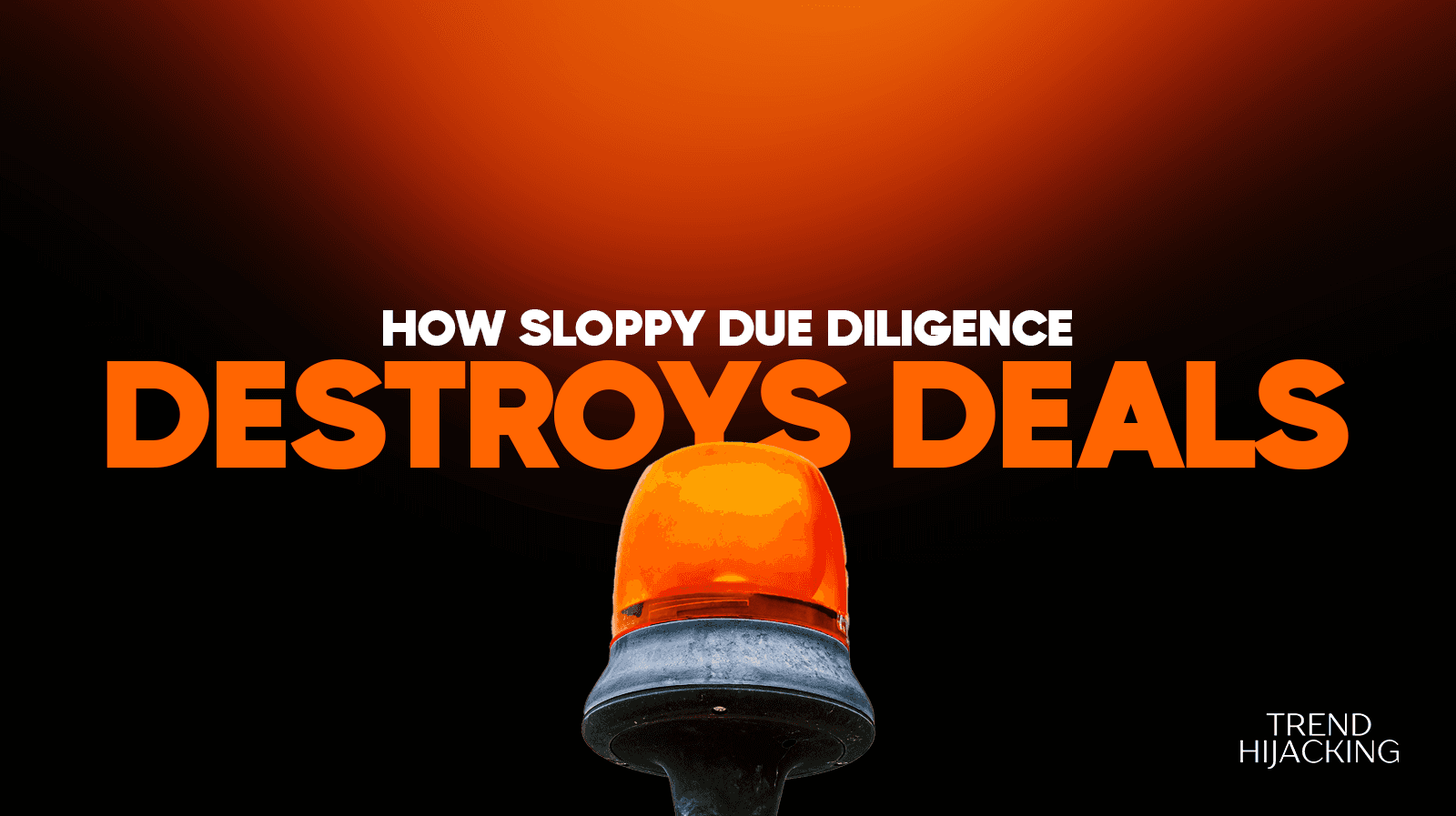5 Costly Mistakes To Avoid When Buying an E-commerce Business
Mistake #1: Running through financial due diligence

This is more common among first-time buyers going at it alone.
They rush to buy an e-commerce business based on surface-level metrics like "$1M/year revenue!"—only to discover post-purchase that:
40% of sales came from one unstable wholesale client who churned.
The "profit" was inflated by one-time spikes now long gone.
The seller quietly slashed ad spend before the sale to make margins look healthier.
These are just a few instances out of many, but the kicker is this:
Basing your buy on metrics like revenue and profit alone is a BIG mistake.
It might seem obvious, but 62% of failed acquisitions cited poor due diligence as a primary reason for their failure.
Not so obvious now, is it?
Especially since revenue and profits can be manipulated by the seller.
So before you buy an e-commerce business, these reports are non-negotiable:
Bank & processor statements (not just P&Ls) – Cross-check every deposit against claimed revenue.
Customer cohort analysis – Spot if "loyal" buyers are actually one-and-done (e.g., if 80% of orders are from first-time purchasers).
Ad account audits – Verify ROAS trends. For instance, a sudden drop-off 3 months pre-sale would be a major red flag.
Supplier Invoices & Cost Sheets — Why? Raw material and production costs directly impact margins. Cross-check against claimed COGS.
Detailed Expense Reports — Uncovers hidden recurring costs (e.g., SaaS tools, freelancers) that P&Ls often gloss over.
Refund & Chargeback Logs — A 10%+ refund rate can turn a "profitable" store into a money pit.
Shipping & Fulfillment Records — Unoptimized shipping costs silently erode profits. Verify contracts and real-world spend.
It’s always a good option to involve accountants in the vetting process and request for access to private accounts(sign an NDA if necessary).
Because the truth is trying to buy an e-commerce business without a financial vetting process is like being open to buying someone else’s problems.
It just doesn’t work well for you.
And even if the numbers check out, most investors overpay by 3-4X for hypothetical "growth potential" instead of proven performance.
We Help You Buy / Build, Manage and Scale E-commerce Brands for an EXIT
E-commerce Simplified for Busy Individuals – We handle the buying, building, and scaling, so you can focus on what matters.
Growth-Focused Strategies – From sourcing to marketing, we drive growth and prepare you for a profitable exit.
Expertly Managed Exits – We build a high-value brand designed for a Lucrative exit.
Mistake #2: Overpaying for “Potential”

There are two mistakes investors make here:
Overpaying and getting swept up by the “potential” of a business rather than focusing on its proven performance.
Here’s how it usually happens…
The seller would tell you about untapped markets, new product lines, or future advertising campaigns that will “unlock exponential growth.”
And while growth opportunities are important, paying a premium for unproven potential isn’t the best choice.
Instead, to make a bang on your buck, prioritize e-commerce businesses that have a consistent track record of profitability before entertaining lofty projections.
Many buyers end up overpaying because they get attached to the seller’s narrative of future success, shelling out 3–4X multiples for what’s essentially just a dream on paper.
Even big names fall into this trap.
In 2013, Yahoo made headlines when it acquired Tumblr for $1.1 billion, banking on the platform’s future advertising potential and expansion into the mainstream social media space.
At the time, Tumblr had an active user base but struggled with generating revenue.
Yahoo’s then-CEO wanted to revitalize Yahoo’s image by appealing to younger audiences through Tumblr.
The acquisition price reflected an optimistic vision of Tumblr’s potential as a revenue-generating advertising platform.
But the problem? That potential never materialized.
Yahoo’s attempts to monetize Tumblr through ad placements and sponsored content didn’t gain traction.
By 2019, Tumblr was sold off to Automattic (the owner of WordPress) for a reported $3 million—a 99.7% LOSS on the initial investment.
Yahoo paid heavily for potential instead of focusing on proven revenue streams.
And that’s a mistake many first-time buyers make when they buy an e-commerce business.
They buy into projections, overpay for speculative growth, and end up hurdling a liability.
The lesson here is simple: Pay for proven economics, not PowerPoints. The best deals succeed without your "magic touch."
Mistake #3: Overlooking Customer Concentration

When you buy an e-commerce business, revenue diversity matters just as much as revenue size.
Yet, many investors completely overlook customer concentration risk.
That is when a significant portion of revenue comes from just a few clients or sales channels. And that is dangerous.
Imagine buying an e-commerce business generating $2M per year, only to find out that 60% of its revenue comes from a single wholesale client.
If that client churns, your revenue drops like a stone.
But it’s not just about clients. Sometimes, it’s reliance on a single ad platform or marketplace.
For example, if an e-commerce brand generates 80% of its revenue from Facebook ads, a sudden algorithm change or ad account suspension can send profits plummeting overnight.
And it's more common than you think.
Blue Apron, the meal-kit delivery service, went public in 2017 with great hype,
Getting partnerships with large-scale distributors and customers.
However, the business was heavily dependent on a small number of big clients to drive revenue.
When those clients started cutting ties, revenue took a nosedive, and Blue Apron’s stock price plunged from $10 per share at IPO to under $1 within a few years.
The lesson? A business built on a few whales can capsize when even one swims away.
So, what’s the fix?
Before you buy an e-commerce business, evaluate customer concentration by:
Reviewing revenue reports broken down by client, sales channel, and marketing platform.
Analyzing the percentage of revenue contributed by top customers. No single client or channel should account for more than 20% of revenue(80-20 rule).
Looking for signs of diversification efforts, such as expanding to new marketplaces or building email lists to reduce dependency on ads.
Now, just because revenue is diversified doesn’t mean you’re in the clear.
In fact, many buyers make the mistake of assuming that diverse revenue means safe revenue. But if that revenue is not consistent, you’re still skating on thin ice…
Mistake #4: Forgetting SOPs After Acquisition

Buying an e-commerce business is just the beginning.
Many investors assume that existing systems are sufficient, or worse, that they can wing it and figure things out as they go.
But that is a big mistake.
What separates successful acquisitions from those that fail within the first few months is being able to implement robust systems and Standard Operating Procedures (SOPs) right from the start.
Here’s why:
When you acquire an e-commerce business, you’re inheriting someone else’s systems, workflows, and processes.
And unless the previous owner was organized, you’re likely dealing with a patchwork of outdated or inefficient procedures.
Even worse, if the business was owner-operated, many of the processes may only exist in their head.
Without systems in place for critical areas like inventory management, order fulfillment, customer service, marketing, and financial tracking, you’re setting yourself up for failure.
A company to look at is Zappos.
They scaled massively because they continuously built and refined their systems.
Their processes were so strong that Amazon acquired them for $1.2 billion in 2009.
Here’s the lesson from this: Systems create scalability.
And without them, even the most promising business can fall apart.
The 3 Post-Acquisition Pillars You Must Build
1. Take Down EVERYTHING (Before Day 1)
Get the seller to record:
Fulfillment workflows
Supplier contact trees
Marketing playbooks, etc.
As soon as you take over, start creating SOPs for every department—marketing, customer support, fulfillment, inventory management, finance, etc.
Leave no task undocumented.
2. Create Your "Growth Machine"
Systematize:
Ad testing (e.g., 3 new creatives/week)
Email sequences (i.e. winback flows for lapsing customers)
Inventory forecasting (tied to ad spend projections)
If you just wing it, then you're one team departure away from chaos.
That being said, you need a team of competent professionals, trained with your systems, if you’re buying an e-commerce business to scale
3. The 30-Day Handover Protocol
Demand the seller:
Stays on for transition calls with major vendors
Records training videos for all tools (ERP, ad platforms)
Provides 90-day performance benchmarks (so you know if you're underperforming or not)
Systems aren’t static.
Make sure to continuously monitor performance and tweak processes to optimize efficiency.
The best acquisitions are built on systems.
And if you choose to neglect them, then you’re gambling with your investment.
Now, if you’ve established killer systems and SOPs, you’re well ahead of the curve.
But there’s one last mistake that can still bring everything crashing down…
Mistake #5: Not Being Exit-Minded Right From Acquisition

Most investors buy an e-commerce business asking, "How can I grow this?"—not "How will I sell this?"
They think, “I’ll worry about that later,” and jump straight into operations.
But here’s the thing:
From the moment you take over, you should be structuring your business as if you’re preparing to sell it.
Why? Because operating with an exit mindset forces you to build a more valuable, resilient, and investor-attractive business—whether you decide to sell in 2 years or 10.
This makes you:
Document processes meticulously—making the business turnkey for potential buyers.
Diversify revenue streams—because a business with multiple stable income sources is worth far more than one with a single cash cow.
Keep clean, transparent financials—which makes due diligence easier and boosts valuation.
But here’s where most investors get it wrong:
They build their business with personal shortcuts, undocumented processes, and are dependent on specific individuals.
Then, when it’s time to sell, they have to scramble to piece everything together, losing money, time, and sometimes entire deals in the process.
A perfect example is Groupon.
Once valued at over $12 billion, it didn’t position itself for a lucrative exit.
They were unsustainable because they relied so much on aggressive customer acquisition tactics without nurturing long-term relationships.
By the time they tried to pivot, it was too late. The valuation dropped by over 90%, and the potential for a successful exit dropped drastically.
The lesson? Every decision you make after acquisition should align with creating a business that’s attractive to potential buyers.
That means setting up proper SOPs and building a stable, scalable operation.
Because whether you intend to sell or not, building your business to be sellable is how you build a business that lasts.
We Help You Buy / Build, Manage and Scale E-commerce Brands for an EXIT
E-commerce Simplified for Busy Individuals – We handle the buying, building, and scaling, so you can focus on what matters.
Growth-Focused Strategies – From sourcing to marketing, we drive growth and prepare you for a profitable exit.
Expertly Managed Exits – We build a high-value brand designed for a Lucrative exit.
How to Buy an E-Commerce Business Without These Mistakes

At this point, you might be thinking: "This is too much—how do I actually execute this correctly?"
That’s where our Trend Hijacking acquisition framework comes in.
We help investors buy undervalued e-commerce businesses so you avoid these 5 costly mistakes by design.
For instance, our “equity cushion” approach that helps you buy a high cashflow e-commerce business with high potential saves you from the risk of overpaying for a liability(mistake #2).
Our team of experts also handles your acquisition(mistake #1 and #3) and creates winning systems and SOPs that ensure scale and streamlines your operations(mistake #4),
Positioning you for a profitable exit when the time is right(mistake #5).
And we handle it every step of the way, saving you additional workload
Want to discover more? Here’s how we help investors like you profitably buy an e-commerce business without the hassle.
The Bottom Line
Acquiring an e-commerce business can be one of the most profitable investments you make—if you do it right.
But falling into these 5 common pitfalls can quickly turn a profitable venture into a costly mistake.
By focusing on proper financial vetting, paying for proven performance over potential, diversifying revenue streams, implementing robust systems, and maintaining an exit-focused mindset, you can drastically improve your chances of a successful acquisition.
Want to see these principles in action? Here’s how we help investors like you profitably buy an e-commerce business without the hassle.
A Done-For-You E-commerce Business
Discover how we Build, Launch, and Scale a 6-figure/month Business for You
Learn more
The 6-Step Blueprint to E-Commerce Acquisition
See how we Acquire, Convert, and Scale with Real Case Studies to Prove It.





















